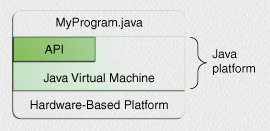
Java technology seems to be everywhere, but what exactly is it? The following sections explain how Java technology is both a programming language and a platform, and provide an overview of what this technology can do for you.
Java technology is both a programming language and a platform. The Java Programming Language is a high-level language that can be characterized by all of the following buzzwords: Simple, Object oriented Distributed, Multithreaded, Dynamic, Architecture neutral, Portable, High performance, Robust, Secure.

Because the Java VM is available on many different operating systems, the same .class files are capable of running on Microsoft Windows, the Solaris™ Operating System (Solaris OS), Linux, or Mac OS. Some virtual machines, such as the Java SE Hotspot at a Glance, perform additional steps at runtime to give your application a performance boost. This includes various tasks such as finding performance bottlenecks and recompiling (to native code) frequently used sections of code. Through the Java VM, the same application is capable of running on multiple platforms.
A platform is the hardware or software environment in which a program runs. We've already mentioned some of the most popular platforms like Microsoft Windows, Linux, Solaris OS, and Mac OS. Most platforms can be described as a combination of the operating system and underlying hardware. The Java platform differs from most other platforms in that it's a software-only platform that runs on top of other hardware-based platforms. The Java platform has two components:
You've already been introduced to the Java Virtual Machine; it's the base for the Java platform and is ported onto various hardware-based platforms. The API is a large collection of ready-made software components that provide many useful capabilities. It is grouped into libraries of related classes and interfaces; these libraries are known as packages. Highlights some of the functionality provided by the API.

The API and Java Virtual Machine insulate the program from the underlying hardware. As a platform-independent environment, the Java platform can be a bit slower than native code. However, advances in compiler and virtual machine technologies are bringing performance close to that of native code without threatening portability. The terms "Java Virtual Machine" and "JVM" mean a Virtual Machine for the Java platform.
The general-purpose, high-level Java programming language is a powerful software platform. Every full implementation of the Java platform gives you the following features:
Java is an object-oriented language, which means that you focus on the data in your application and methods that manipulate that data, rather than thinking strictly in terms of procedures. In an object-oriented system, a class is a collection of data and methods that operate on that data. Taken together, the data and methods describe the state and behaviour of an object. Classes are arranged in a hierarchy, so that a subclass can inherit behaviour from its superclass. Java comes with an extensive set of classes, arranged in packages that you can use in your programs. Distributed it has a spring-like transparent RPC system
Security is an important concern, since Java is meant to be used in networked environments. Without some assurance of security, you certainly wouldn't want to download an applet from a random site on the net and let it run on your computer. Java's memory allocation model is one of its main defences against malicious code (e.g. can't cast integers to pointers, so can't forge access). Furthermore:
Java is an interpreted language, so it will never be as fast as a compiled language as C or C++. In fact, it is about 20 times as slow as C. However, this speed is more than enough to run interactive, GUI and network-based applications, where the application is often idle, waiting for the user to do something, or waiting for data from the network.
Java allows multiple concurrent threads of execution to be active at once. This means that you could be listening to an audio clip while scrolling the page and in the background downloading an image. Java contains sophisticated synchronization primitives (monitors and condition variables), that are integrated into the language to make them easy to use and robust. The java.lang package provides a Thread class that supports methods to start, run, and stop a thread, and check on its status.
Java was designed to adapt to an evolving environment: